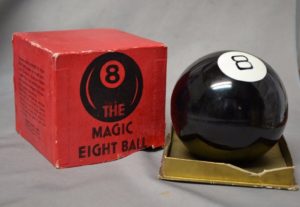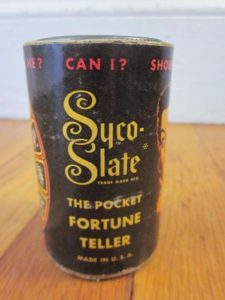
In the 1940’s Mary Carter lived in Cincinnati, making a lucrative living holding fake seances.
Mary was also inventive. She created a slate that would appear to be sealed inside a box, inside which she was able to write messages “from the spirit world.” When she opened the box, her customers were amazed to see messages scrawled on the slate.
Her son Alfred admired the invention, but he realized that it took real skill and dexterity, which his mother possessed in droves, to operate the magic slate. So he set about inventing a device that would “tell the future” in a manner that required no input from the user.
In 1944, Carter created a tube divided in two by a wall that ran throughout its length. The tube had a die in each half, with a windows on each end allowing only one die to be seen. The dice floated, and the tube was filled with a dark, thick liquid. Answers were printed on each die. So the tube would reveal one answer, then it could be turned over and it would reveal another one.

The tube was called the Syco-Seer, also the Syco-Slate, in honor of his mother’s creation. Carter took prototypes to a local retailer, and he expressed interest in selling them in his store, and also wholesaling to other establishments.
So Carter turned to his brother-in-law, Abe Bookman, who is credited with the invention of the Magic Eight-Ball. Carter obtained patents for his tubes, then assigned them to Bookman.
At this point, Carter became so enslaved to alcohol that he left all for Bookman to handle, as he descended into a life of sleeping in flophouses.
Bookman surged ahead, marketing the Syco-Seer to as many stores as he could. Alabe Crafts, the company he formed with Carter, was producing the devices in steady numbers. Stores would hire women to dress in Gypsy clothing to demonstrate the “amazing” fortune telling tubes.
In 1950, Brunswick, manufacturers of billiard equipment and other sporting goods, commissioned Alabe to make Syco-Seers shaped as eight-balls. The promotion was modestly successful for Brunswick, but Bookman thought the tube reworked into an eight-ball would be a much greater hit among the masses.
He was right. After his commitment to Brunswick ran its course, he began cranking out Magic Eight-Balls for his own company to sell. And sell they did!
At first, it was marketed as a paperweight. But as time went by, it was aimed at kids as a toy, and that’s when things really took off. Sales went up and stayed up.
Nowadays, the Magic Eight-Ball is sold by Mattel at about a million units a year. It has become part of human culture. They are found in kids’ bedrooms, executives’ desks, and everywhere in between. It’s been seen or mentioned in movies, television shows, and novels. It even had homage paid to it in the form of a Microsoft Word “easter egg,” or hidden trick in a program. On an early version of Word, you could create a blank macro called “Magic Eight-Ball” and it would place an eight-ball icon on your toolbar.
Minor, I know, but it shows you that Redmond programmers dig Al Carter’s creation too.